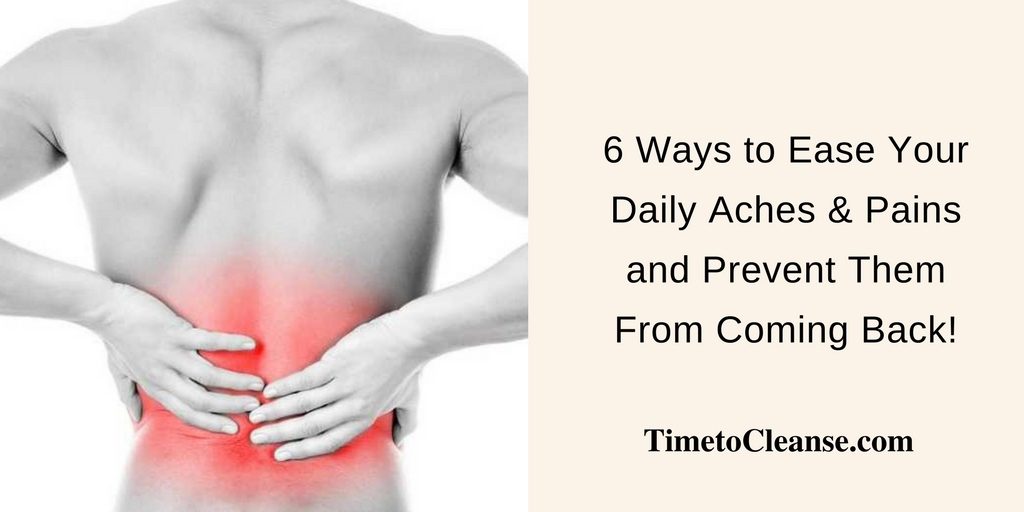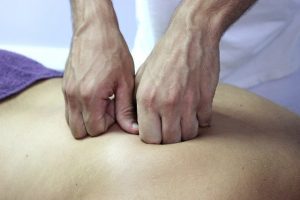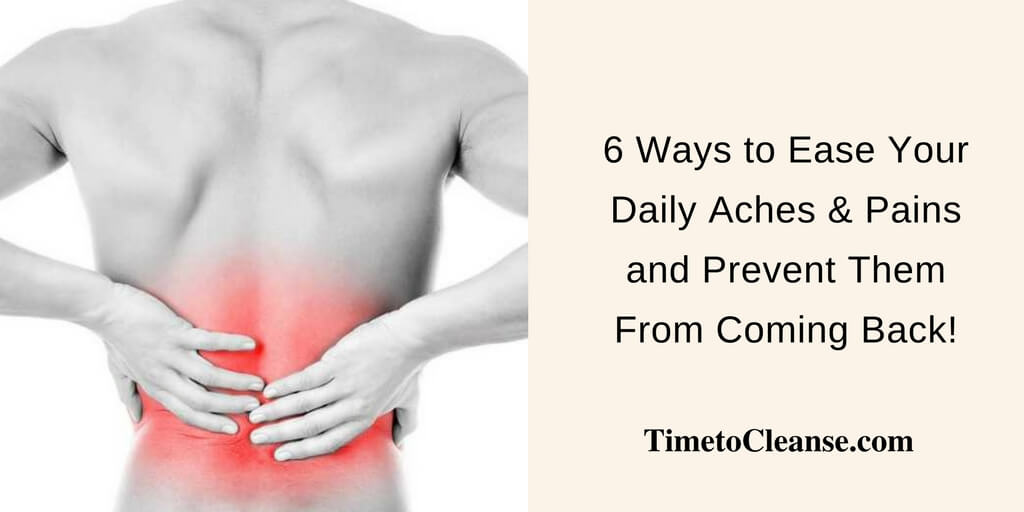
If you are one of the millions of people who suffer from chronic pain, you may believe you only have two options: to pop pills or just deal with it till it passes.
However, doctors and modern medical institutions are increasingly turning to natural pain relief alternatives such as massage therapy, acupuncture, yoga, guided imagery and hypnosis to help patients like you feel better.
Here are six ways to ease your daily aches and pains and (hopefully) prevent them from coming back.
Quiz: Is Your Body TOXIC? Take the Test...
(get your free personalized report)
1. Lower Back Pain
Lower back pain is the most common type of chronic pain with millions of sufferers from around the world.
Even if you haven’t suffered a back injury yet, by the time you reach your 30s or 40s, there is a good chance that you will. A sedentary lifestyle which involves sitting down for long stretches is usually to blame. On the other hand, as an older adult, you are more likely to have back pain from conditions such as arthritis.
To combat lower back pain, try to incorporate strength training and cardio exercises into your routine.These types of workouts increase your blood flow and help you to strengthen your core muscles (which support your spine), thereby reducing pressure on the back.
Physical therapy is also another option,as trained physical therapists can introduce you to exercises and movements that aid in helping you move better and relieve pain. Additionally, a heating pad works well for many people as an immediate though temporary salve.
Massage therapy works well for patients experiencing back pain, osteoarthritis, tension headaches,neck pain and surgery-related discomfort as they boost the levels of endorphins and serotonin in the body. These natural painkillers and mood regulators help reduce stress hormone levels.
Quiz: Is Your Body TOXIC? Take the Test...
(personalized report)
2. Headaches
 Whether they are regular headaches or migraines, millions of people around the world are battling this type of chronic pain every day. Globally, numbers show there are 1.24 billion people suffering from tension-type headaches, enduring years lived with disability.These headaches can be caused by a wide variety of factors including dehydration, stress, muscle tension and weather changes.
Whether they are regular headaches or migraines, millions of people around the world are battling this type of chronic pain every day. Globally, numbers show there are 1.24 billion people suffering from tension-type headaches, enduring years lived with disability.These headaches can be caused by a wide variety of factors including dehydration, stress, muscle tension and weather changes.
Tension headaches occur in the forehead and temple area. If this is what you are experiencing, massage the area and apply menthol cream on your forehead or at the base of your neck.
In the short-term, pain medication such as ibuprofen, acetaminophen or medicine formulated for migraines can offer some relief. However, avoid taking any type of medication without consulting with your doctor first. Start with natural therapies such as getting a head massage from a well-trained and qualified massage therapist.
3. Osteoarthritis
Osteoarthritis is a prevalent condition that develops when the protective cartilage between joints and bone begins to crack. When this happens, it can cause severe pain in the joints of the hands, knees, and hips. It is often the result of age-related changes, an injury, or wear-and-tear from a sport or any other physical activity
Because this condition can affect mobility and strength some people may benefit from specific rollators, walking canes or other mobility devices to provide support as and when required.
Staying physically active is vital to combating osteoarthritis as it ensures that your blood is circulating, keeping your joints healthy and reducing pain. Physical activity also strengthens your muscles around the joints, thus taking pressure off the joints and the bones.
Many people find relief from osteoarthritis by applying heat when their joints are stiff, and then ice when they become swollen. Studies also say eating gelatin can help ease joint damage and inflammation.
4. Non-Arthritis Joint Pain
If you don’t have osteoarthritis, yet you feel pain in or around your joints, then it may be tendinitis.This occurs when your tendon – a band of tissue that connects your muscles to your bones – is inflamed. Often, with non-arthritis joint pain, the more you move, the more pain you feel. It’s usually caused by activities that involve repetitive motion, like golfing and shoveling.
Once you reach age 40, your tendons become less elastic and are more prone to injury. To ease the pain, apply RICE (rest, ice, compression and elevation). Put an ice pack on the sore area and take a break from those activities that aggravate your joints. When in pain, wrap the joint in a bandage, and prop up the affected area.
5. Carpal Tunnel Syndrome
Carpal tunnel syndrome occurs when a nerve that runs from your arm to your palm is pressed or squeezed. Often happening around your mid-40s to mid-60s, carpal tunnel syndrome causes pain in the fingers and wrists, as well as numbness or a tingling sensation.
It is usually caused by repetitive motion such as typing or using machinery. The condition is also one of the most common health risks associated with desk jobs. However, other factors, such as a family history of carpal tunnel syndrome, arthritis, and menopause-related hormonal changes can also increase your chances of getting it.
If you think you are suffering from carpal tunnel syndrome, talk to your doctor. They may suggest exercise, occupational and physical therapy, or short-term use of over-the-counter pain relievers. Massage therapy is also used in carpal tunnel cases as it can improve circulation and relieve inflammation and irritation in the affected muscles and tendons.In some more severe cases, surgery may be the only way to treat this problem.
6. Muscle Strain or Pain
 Unfortunately, throughout the years, your muscle fibers become less dense which causes them to become less flexible, and more susceptible to injury and soreness. This is why you are more likely to experience pain after activities such as gardening or exercise that you used to do without any issues.
Unfortunately, throughout the years, your muscle fibers become less dense which causes them to become less flexible, and more susceptible to injury and soreness. This is why you are more likely to experience pain after activities such as gardening or exercise that you used to do without any issues.
In these scenarios, the best thing to do to avoid this pain is to try not to hurt yourself in the first place. Seek help when lifting, pushing, or pulling heavy items.
Incorporate regular stretching and exercises such as yoga and Pilates into your weekly routine. These movements can assist your muscles in staying long and limber, and can also aid in your recovery when you’re feeling sore.
No matter what type of chronic pain you are experiencing, meditation is one of the best ways to manage your daily aches and pains. If you want to try meditation, but are not sure where to start, attempt some simple breathing exercises which can help to lessen your feelings of pain.
- First, sit or lie in a comfortable, and place the tip of your tongue just behind your upper teeth.
- Next, exhale completely through your mouth, while making a gentle “whoosh” sound.
- Then, close your mouth and inhale quietly through your nose to a count of four.
- At this point, hold your breath for a count of seven.
- Finally, exhale completely through your mouth (“whoosh”) to a silent count of eight.
- Inhale, and repeat the cycle three more times.
Learning the natural ways to breathe better recommended for asthma sufferers can also be beneficial even if you don’t have the condition.
You don’t have to live with pain or always turn to medication to manage it. Try to incorporate some of the natural therapies and remedies mentioned above so you get to live a more wholesome and pain-free lifestyle.
AUTHOR BIO
Marc Innes is the Owner and Principal of the School of Natural Therapies, a training school for Massage & Holistic Therapies located in London. Marc began his career in the NHS, working in a number of managerial and training roles within the Ambulance Service in London. He spent much of that time educating and coaching medical staff. Over time, he developed an interest in all things complementary to Allopathic Medicine, in particular, Reiki Healing and EFT, which culminated in running a successful teaching and ‘energy healing’ practice. Marc is passionate about the and complementary therapy industry.

